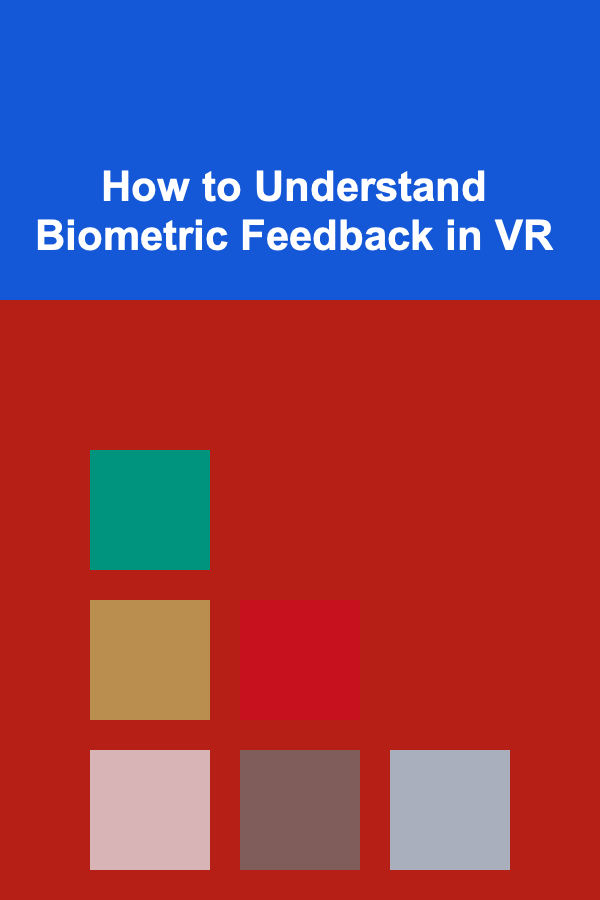
How to Understand Biometric Feedback in VR
ebook include PDF & Audio bundle (Micro Guide)
$12.99$8.99
Limited Time Offer! Order within the next:

Virtual Reality (VR) has become one of the most innovative technologies, reshaping various industries, from entertainment to healthcare, education, and beyond. As VR technology evolves, its immersive capabilities have expanded, offering users a deeply engaging experience. One of the critical factors contributing to the level of immersion is biometric feedback in VR. Understanding how biometric feedback works and how it enhances VR experiences is crucial for developers, users, and those interested in the potential applications of VR.
This article explores biometric feedback in Virtual Reality, examining its definition, importance, integration with VR systems, and its various applications and future implications.
What is Biometric Feedback?
Biometric feedback refers to the physiological data that can be measured and monitored from the user's body during their interaction with a system, such as heart rate, skin temperature, brain activity, eye movements, and muscle tension. When integrated into VR, this data is used to measure the user's emotional and physiological responses to virtual environments.
In the context of VR, biometric feedback works as a means to bridge the gap between physical reality and the virtual world. It involves using sensors and devices to collect real-time information about a user's body while they engage with VR content. These biometric markers are then used to tailor or adjust the virtual experience based on how the user is feeling or responding physiologically.
Types of Biometric Feedback in VR
- Heart Rate Monitoring: This measures the number of heartbeats per minute, providing insights into a person's emotional arousal, stress, excitement, or relaxation levels.
- Eye Tracking: Eye-tracking technology is used to determine where a person is looking, how their gaze shifts, and how long they focus on specific objects or stimuli in the virtual environment. This helps gauge attention, focus, and fatigue.
- Skin Conductance (Galvanic Skin Response - GSR): Skin conductance is the measurement of the skin's ability to conduct electricity, which increases when a person is stressed or anxious. This feedback can help understand emotional engagement or distress in response to virtual stimuli.
- Muscle Activity: Devices like electromyography (EMG) sensors can monitor muscle tension or relaxation, providing insights into the user's physical state while interacting with VR content.
- Brainwaves: Brainwave measurement technologies such as EEG (electroencephalography) can capture brain activity and give information about a user's mental state, such as focus, relaxation, or stress.
- Posture and Movement: Wearable sensors can track the user's body posture and movements, providing feedback on their level of comfort or discomfort, fatigue, and engagement in the VR experience.
These forms of biometric data, when collected and analyzed in real-time, offer significant insight into how users are interacting with the virtual environment, enabling more tailored, immersive, and dynamic VR experiences.
How Biometric Feedback Enhances Immersion in VR
One of the defining features of Virtual Reality is its ability to create a fully immersive experience. Biometric feedback adds an important layer to this immersion by making VR environments responsive to the user's physical and emotional states. This dynamic response is central to creating more interactive and engaging VR experiences.
1. Adaptive VR Content
When biometric feedback is integrated with VR, it allows for the adaptation of the virtual environment to fit the user's emotional and physiological states. For example, if a user becomes stressed or anxious, their heart rate or skin conductance could trigger a change in the VR environment, such as adjusting the intensity of a game or providing calming effects like soothing sounds and visuals.
This adaptability is crucial for providing a more personalized experience. If a user's heart rate increases due to excitement or fear, the system could adjust to maintain the user's comfort, creating a more enjoyable and less overwhelming VR interaction.
2. Real-Time Emotional Tracking
Biometric data provides real-time insights into how users are emotionally reacting to VR stimuli. For instance, if a VR horror game is too intense and raises the user's heart rate significantly, the system can adjust the game mechanics or visuals to ensure that the experience remains engaging but not excessively stressful.
This type of emotional tracking allows developers to create more refined experiences. Games, simulations, and training programs can become more adaptive to individual needs, ensuring that users are not overwhelmed or bored during their VR experience.
3. Biofeedback for Learning and Training
Biofeedback is an increasingly popular tool in education and training simulations. By monitoring users' biometric feedback, VR systems can provide real-time responses to help guide the learner. For instance, in training programs that require focus and concentration, such as medical simulations or stress management exercises, biometric feedback can help assess the learner's engagement and stress levels, adjusting the difficulty or pace accordingly.
Additionally, biofeedback can help users improve their self-regulation and mental resilience. In VR environments that focus on stress management, meditation, or relaxation, the system can track users' brainwaves, heart rate, and skin conductance, offering feedback to help them relax or refocus when necessary.
Applications of Biometric Feedback in VR
1. Healthcare and Therapy
Biometric feedback is already proving invaluable in healthcare, particularly in the fields of mental health, physical therapy, and rehabilitation. VR offers a controlled, immersive environment where biometric data can be used to monitor and treat various conditions.
a. Mental Health and Stress Relief
VR, when paired with biometric feedback, is being used in the treatment of anxiety, PTSD, and other stress-related conditions. By monitoring a patient's heart rate, eye movement, and skin conductance, VR experiences can be tailored to create therapeutic environments that promote relaxation, mindfulness, or exposure therapy. This is particularly beneficial for patients who may have difficulty expressing their emotional states or fear exposure to real-world situations.
For example, during exposure therapy, the VR environment can simulate stressful scenarios (e.g., public speaking or flying) while biometric data is used to monitor the user's anxiety levels. Based on this data, the intensity of the exposure can be adjusted, allowing patients to gradually confront their fears in a safe and controlled environment.
b. Physical Rehabilitation
VR-based rehabilitation programs are increasingly used for physical therapy. Biometric feedback, including muscle activity and movement tracking, enables therapists to monitor a patient's progress and tailor rehabilitation exercises in real-time. For example, if a patient is undergoing rehabilitation after a stroke, VR can simulate movement exercises while biometric sensors provide feedback on muscle activity, guiding adjustments to the therapy as needed.
2. Gaming and Entertainment
In gaming, biometric feedback has the potential to significantly enhance user engagement. By monitoring heart rate, eye movement, and facial expressions, game developers can design more immersive experiences where the virtual world reacts to the player's emotional state.
In VR games, the feedback could trigger specific in-game events depending on the player's emotional response. For instance, if a player's heart rate increases during a suspenseful moment, the game may react by intensifying the experience with additional visual or auditory cues. This feedback loop creates a more engaging experience, as players feel like they are influencing the environment through their own physical responses.
3. Education and Training Simulations
In training simulations, particularly those used for high-stakes situations (e.g., medical, military, or emergency response), biometric feedback is an invaluable tool. By monitoring the stress and concentration levels of trainees, instructors can assess how well the trainee is coping with stressful situations and adjust the simulation to ensure optimal learning conditions.
For example, in a military training scenario, biometric sensors could track a trainee's heart rate and muscle tension. If the trainee is becoming overwhelmed, the simulation could be adjusted to reduce intensity or provide a calming environment. This feedback is crucial for creating effective learning environments where trainees are both challenged and supported.
4. Sports Training
In sports training, VR and biometric feedback are being combined to optimize performance. Athletes can wear sensors to monitor their heart rate, muscle activity, and brainwaves while engaging in VR simulations of sports scenarios. This data can help trainers assess the athlete's physical and mental readiness, allowing them to optimize training sessions and prevent overtraining.
For instance, a runner might use a VR simulation to train in different environments, such as running on a track or in an urban setting, while biometric sensors provide feedback on the athlete's endurance and stress levels. The VR system could adapt the simulation to help the runner maintain peak performance and avoid fatigue.
Challenges and Limitations of Biometric Feedback in VR
Despite its many advantages, there are several challenges to integrating biometric feedback with VR technology. Some of the most significant limitations include:
1. Privacy Concerns
The collection of biometric data raises significant privacy issues. Users may be concerned about how their personal physiological data is being stored, shared, or used. Clear privacy policies and strong data protection measures are necessary to ensure that users feel comfortable sharing their biometric information.
2. Cost and Accessibility
The integration of biometric sensors into VR systems can be expensive, especially in fields like healthcare and education. High-end VR systems that include biometric sensors may not be accessible to all users, especially those in lower-income settings or regions. Additionally, the cost of developing and maintaining VR-based biofeedback systems can be prohibitive for some organizations.
3. Data Interpretation and Accuracy
Interpreting biometric data accurately can be complex. For example, heart rate variability may indicate stress, but it can also reflect other factors, such as physical activity or health conditions. Ensuring that biometric data is correctly interpreted and applied in the context of VR experiences is essential for delivering accurate and useful feedback.
Conclusion
Biometric feedback is poised to play a central role in the development of immersive Virtual Reality experiences. By incorporating physiological data such as heart rate, eye movement, and brain activity, VR can create adaptive, responsive environments that cater to the user's emotional and physical states. This feedback loop enhances immersion, personalization, and engagement, enabling more dynamic interactions in gaming, healthcare, education, and training. As technology evolves, the integration of biometric feedback with VR will undoubtedly open new possibilities, improving user experiences and fostering more intuitive, adaptive virtual environments.
Reading More From Our Other Websites
- [Home Rental Property 101] How to Make Your Rental Property Stand Out in a Crowded Market
- [Organization Tip 101] How to Keep Track of Appliances and Electronics in Your Home
- [Personal Care Tips 101] How to Care for Men's Beards: Personal Grooming Tips for a Healthy Beard
- [Organization Tip 101] How to Choose the Right Grab Bars for Your Bathroom Safety
- [Home Pet Care 101] How to Give Your Pet a Pill Easily
- [Organization Tip 101] How to Use Wall Space for Effective Home Organization
- [Personal Care Tips 101] How to Choose a Lip Balm with Organic Ingredients
- [Organization Tip 101] How to Create a Maintenance Schedule for Your Home
- [Personal Care Tips 101] How to Use Hair Gel to Keep Your Hair in Place During a Workout
- [Personal Care Tips 101] How to Maximize the Benefits of a Facial Scrub with Proper Technique

Database Optimization Techniques: Strategies for a Professional DBA
Read More
What Are the Most Effective Ways to Declutter Your Mind?
Read More
10 Tips for Securing AI Research Funding
Read More
How to Track Weekly Spending for Travel Savings
Read More
How to Create a Personalized Gift Wrap Checklist for Loved Ones
Read More
10 Tips for Creating a Chore Chart That Actually Works
Read MoreOther Products

Database Optimization Techniques: Strategies for a Professional DBA
Read More
What Are the Most Effective Ways to Declutter Your Mind?
Read More
10 Tips for Securing AI Research Funding
Read More
How to Track Weekly Spending for Travel Savings
Read More
How to Create a Personalized Gift Wrap Checklist for Loved Ones
Read More